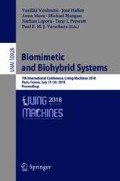Abstract
In this study we assess the ability of the TacTip to classify a range of 12 textured stimuli with particle sizes ranging from 642 \(\mathrm {\mu }\)m to 15 \(\mathrm {\mu }\)m. We observe stick-slip events at the interface between sensor and stimulus which vary depending on the texture. We compare the use of marker position with marker velocity for encoding texture and found the velocity feature performed substantially better with a RMS error of \(\sim \)1.4 stimulus classes compared with \(\sim \)2.3 for the position feature. Marker velocity is analogous to rapidly adapting mechanoreceptors, such as Meissner’s corpuscles, which are thought to be used for roughness perception, therefore this result may be indicative of the biology of human touch.
Access this chapter
Tax calculation will be finalised at checkout
Purchases are for personal use only
References
Klatzky, R.L., Lederman, S.J.: Toward a computational model of constraint-driven exploration and haptic object identification. Perception 22(5), 597–621 (1993)
Chorley, C., Melhuish, C., Pipe T., Rossiter, J.: Development of a tactile sensor based on biologically inspired edge encoding. In: International Conference on Advanced Robotics, pp. 1–6 (2009)
Ward-Cherrier, B., Pestell, N., Cramphorn, L., Winstone, B., Elena Giannaccini, M., Rossiter, J., Lepora, N.F.: The TacTip family: soft optical tactile sensors with 3D-printed biomimetic morphologies. Soft Robot. 5(1), 1–12 (2017)
Lepora, N.F., Ward-Cherrier, B.: Superresolution with an optical tactile sensor. In: International Conference on Intelligent Robots and Systems, pp. 2686–2691 (2015)
Cramphorn, L., Ward-Cherrier, B., Lepora, N.F.: Addition of a biomimetic fingerprint on an artificial fingertip enhances tactile spatial acuity. IEEE Robot. Autom. Lett. 2(3), 1336–1343 (2017)
Hollins, M., Risner, S.R.: Evidence for the duplex theory of tactile texture perception. Percept. Psychophys. 62(4), 695–705 (2000)
Winstone, B., Griffiths, G., Pipe, T., Melhuish, C., Rossiter, J.: TACTIP - tactile fingertip device, texture analysis through optical tracking of skin features. In: International Conference on Biomimetic and Biohybrid Systems (2013)
Dargahi, J., Najarian, S.: Human tactile perception as a standard for artificial tactile sensing-a review. Int. J. Med. Robot. Comput. Assist. Surg. 1(1), 23–35 (2005)
Author information
Authors and Affiliations
Corresponding author
Editor information
Editors and Affiliations
Rights and permissions
Copyright information
© 2018 Springer International Publishing AG, part of Springer Nature
About this paper
Cite this paper
Pestell, N., Lepora, N.F. (2018). Texture Perception with a Biomimetic Optical Tactile Sensor. In: Vouloutsi , V., et al. Biomimetic and Biohybrid Systems. Living Machines 2018. Lecture Notes in Computer Science(), vol 10928. Springer, Cham. https://doi.org/10.1007/978-3-319-95972-6_39
Download citation
DOI: https://doi.org/10.1007/978-3-319-95972-6_39
Published:
Publisher Name: Springer, Cham
Print ISBN: 978-3-319-95971-9
Online ISBN: 978-3-319-95972-6
eBook Packages: Computer ScienceComputer Science (R0)

